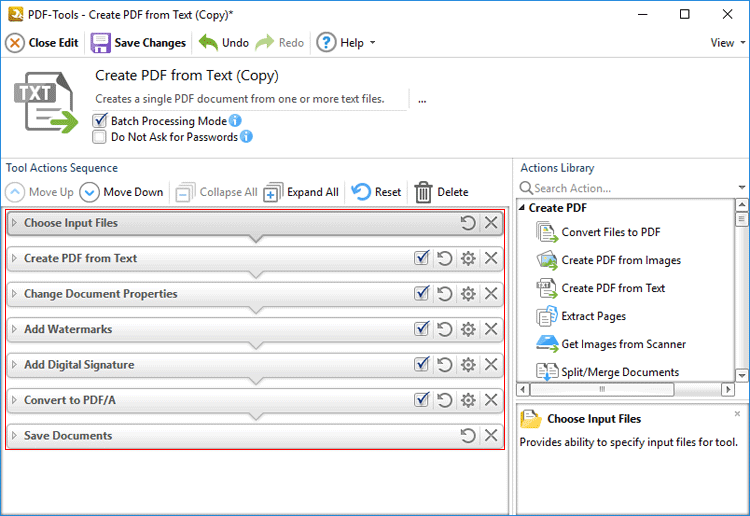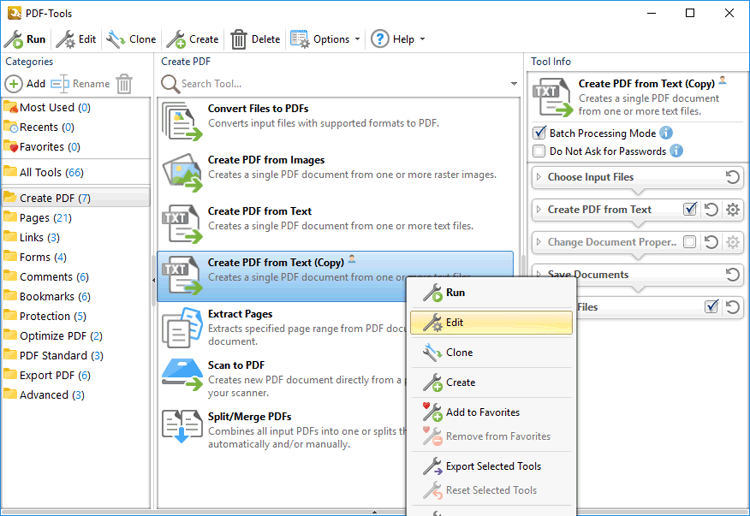![]() Clone Tool
Clone Tool
The Clone Tool feature of PDF-Tools is used to clone tools. This makes it possible to duplicate tools and then customize their settings whilst retaining the existing tool and its parameters. This is especially useful in the case of the default tools, as many of their parameters are locked by default. Cloning the default tools makes it possible to add/remove actions to/from the Tool Actions Sequence as desired, and thus enables the advanced customization of tools. For example, the Create PDF from Text tool is used to convert text files into PDF format, and it uses five actions from the Actions Library to achieve this:

Figure 1. Create PDF from Text, Tool Actions Sequence
When the tool is launched it will prompt the user for input text files, convert them into PDF format, change document properties, save the files according to user specifications and display them in their desktop folder. If this tool is cloned then further options become possible. For example, the Show Files action could be removed and the Add Watermark, Add Digital Signature and Convert to PDF/A actions could be added. The Tool Actions Sequence would then be as follows:

Figure 2. Create PDF from Text Tool Clone, Updated Tool Actions Sequence
The tool would then prompt the user for input text files, convert them into PDF format, change document properties, add a customized watermark and digital signature, convert the files to PDF/A and save them according to the user's specifications (but not display them in their containing folder on the desktop, as in the default settings of the tool).
Cloning and Editing Tools
Follow the steps below to clone tools:
1. Right-click the desired tool and click Clone in the submenu:

Figure 3. Right-Click Content Menu for Tool, Clone Option
The PDF-Tools dialog box will open:

Figure 4. PDF-Tools Dialog Box, Tool Name Text Box
2. Enter a name for the cloned tool and click OK. It will then be available in the main window. Right-click the cloned tool and then click Edit:

Figure 5. Main Window, Cloned Tool Right-Click Menu
The Edit window for the tool will open:

Figure 6. Cloned Tool Edit Window
•Click the ![]() icon to expand/collapse actions. Available parameters are displayed when actions are expanded. A complete breakdown of all actions and their parameters is available here.
icon to expand/collapse actions. Available parameters are displayed when actions are expanded. A complete breakdown of all actions and their parameters is available here.
•Click the ![]() icon to revert to default parameters after action parameters have been changed.
icon to revert to default parameters after action parameters have been changed.
•Click the ![]() icon to remove actions from the Tool Actions Sequence.
icon to remove actions from the Tool Actions Sequence.
•Actions that feature a check box are optional. A selected box means actions are included in the Tool Actions Sequence when the tool runs. A cleared box means that actions are skipped when the tool runs, but are retained in the Tool Actions Sequence for subsequent use. (This is a useful feature in cases where actions are required only some of the time).
•Drag actions from the Actions Library (or double-click them) to add them to the Tool Actions Sequence. There are sixty-nine available actions. See the Actions Library for an explanation of all actions and their associated parameters.
•The order of actions in the Tool Actions Sequence determines their order of operation when tools run. Select actions and then click the Move Up or Move Down buttons displayed in (figure 6) to change their order in the Tool Actions Sequence. Several actions require additional actions in order to function correctly. Additional actions may be required before (prerequisite) or after (postrequisite) actions. For example the Create PDF From Text action requires both an action that sources input files to convert to PDF and an action that saves converted files. If an ordering mistake is made then a warning icon will appear. Click the icon for further information and a solution to the issue.
•The Batch Processing Mode setting determines the processing method in cases of multiple input files. It is enabled by default, which means files are processed simultaneously. Clear the Batch Processing Mode box to process input files one at a time instead. Disabling this option should reduce memory usage, but it may also result in unexpected output for tools that combine input files into single documents.
•The Do Not Ask for Passwords setting is disabled by default. This means that PDF-Tools will prompt for passwords in cases of password-protected input files that do not have corresponding passwords in Predefined Passwords Storage. Enable this option to skip these files when tools run.
•The Edit window (figure 6) and the options it contains are detailed here.
3. Click ![]() Save Changes to save changes to tools.
Save Changes to save changes to tools.